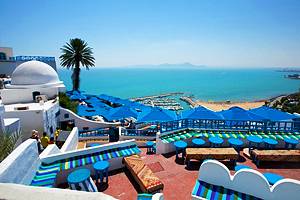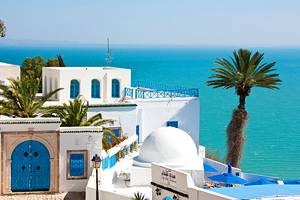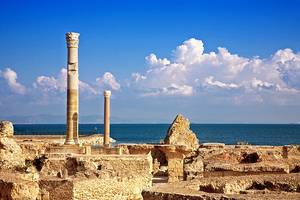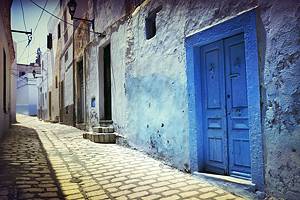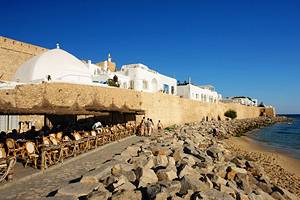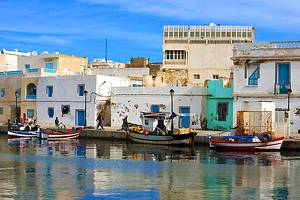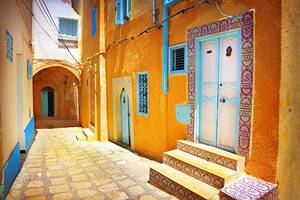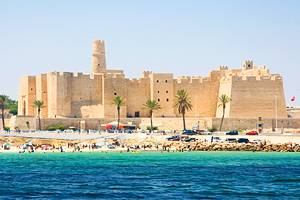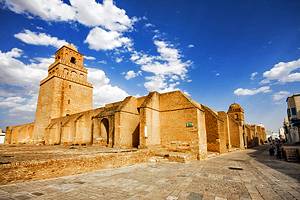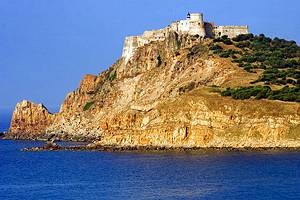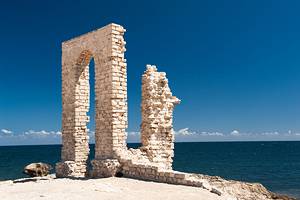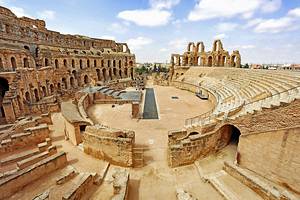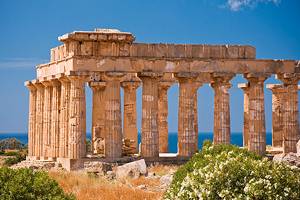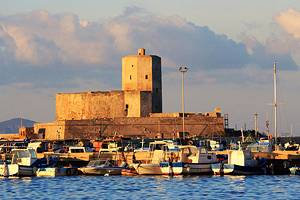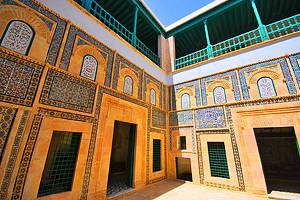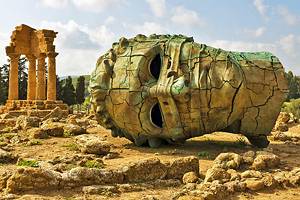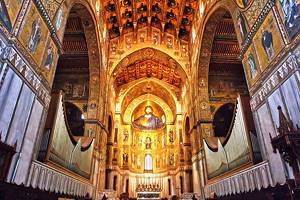Exploring Sidi Bou Said: Tunis' Picturesque Seaside Suburb

Impossibly picturesque, Sidi Bou Said is Tunis' bohemian seaside suburb, full of photo-perfect whitewashed buildings with wrought-iron window dressings and sky-blue wooden doors.
One of the most popular things to do here for tourists is simply kick back with a cappuccino and enjoy watching the world stroll by. You can also wander amid the quiet back streets (cars are banned) and take a cue from the relaxed ambience.
With its credentials as a hip hangout for those of an artistic nature, this is also one of Tunisia's top places to visit to pick up the ceramic work for which the country is famed.
On This Page:
Sights of Sidi Bou Said

Sightseeing in Sidi Bou Said is more about strolling the lanes while soaking up the atmosphere than a list of monuments and attractions, but don't miss a coffee or tea at Cafe des Nattes (upper end of the main square), where time has done little to change the exterior or interior of this typical coffeehouse.
If you're looking for the best views, stroll up to the Mausoleum of Abu Said el Baji (below the lighthouse) from where there are incomparable views of the Gulf of Tunis, Carthage, La Goulette, and Tunis itself.

Most people come here simply for a long, lazy lunch and to enjoy the café life, with maybe a spot of ceramics shopping thrown in afterwards.
It's busiest in the afternoons and early evening, particularly on weekends, when Tunis locals come to enjoy a coffee and tea overlooking the sea. If you want to photograph the narrow lanes, come during the morning when there are less people about.
Palace Dar Nejma Ezzahra

Sidi Bou Said's main tourist attraction is the Palace Dar Nejma Ezzahra. This lovingly restored old residence dates from the early 20th century, when it was built for the French painter and musicologist Baron Rodolphe d'Erlanger, who is renowned for his multi-volume work tracing the history of Arab music.
The Baron's vast collection of traditional musical instruments are on display inside, as are some of his paintings.
The real reason for a visit here, though, is to view the interior, with its intricate craftwork features that cherry pick the best of traditional Tunisian architecture, and to see the gardens with their magnificent views across the Mediterranean.
The palace is the home base of the Center of Arab and Mediterranean Music, which is dedicated to promoting and preserving Tunisian and Arab musical heritage. The organization runs a regular program of events within the palace grounds, hosting evening performances of local and international musicians.
Address: Rue du 2 Mars
Museum Dar el-Annabi

This is a great chance for a peek inside a traditional-style Sidi Bou Said house. The family that live here have opened up some of the rooms, so that visitors can view the typical design and layout of local houses.
Some rooms contain rather dusty dioramas depicting local life, but the true highlight here is simply viewing the interiors with their colorful ceramic tile and stained glass details.
After a visit, tea is usually offered in the courtyard by the family; a great chance to chat to Sidi Bou Said locals.
Address: Rue Habib Thameur
Art Galleries in Sidi Bou Said

Continuing Sidi Bou Said's artistic heritage, today there are several small art galleries here focused on the artwork of contemporary Tunisian painters.
The two best are the Ghaya Gallery (Place de la Gare) and the A Gorgi Gallery (Rue Sidi El Ghemrini) who both spotlight local artists with a schedule of rotating exhibitions.
How to Get to Sidi Bou Said
The easiest way to get to Sidi Bou Said by public transport is to use the light railway line between central Tunis and Sidi Bou Said station. Trains operate approximately every 30 minutes on this line.
The trains stop at several points in the suburb of Carthage along the way, so many visitors plan to visit the Carthage ruins first, in the morning, and then journey onto Sidi Bou Said for lunch and a relaxed afternoon of wandering the lanes before heading back to Tunis.
History of Sidi Bou Said
It was here in around 1207 that the Sufi teacher Abu Said el Baji established his Sufi order and settled, attracting many admirers and adherents to his preaching.
When members of the Husainid dynasty took up residence here in the 18th century, they brought with them many leading musicians and writers of the day.

This laid the foundations for Sidi Bou Said's reputation as an artists' village. Thereafter, it soon developed into an internationally known haunt of artists.
Thanks to the efforts of the French artist and musicologist Baron Rodolphe d'Erlanger, author of a six-volume encyclopedia on Arab music, the village was given statutory protection in 1915 to ensure that it would be preserved in its original state.


